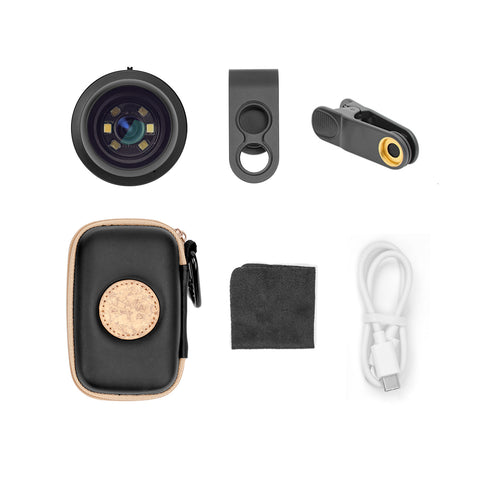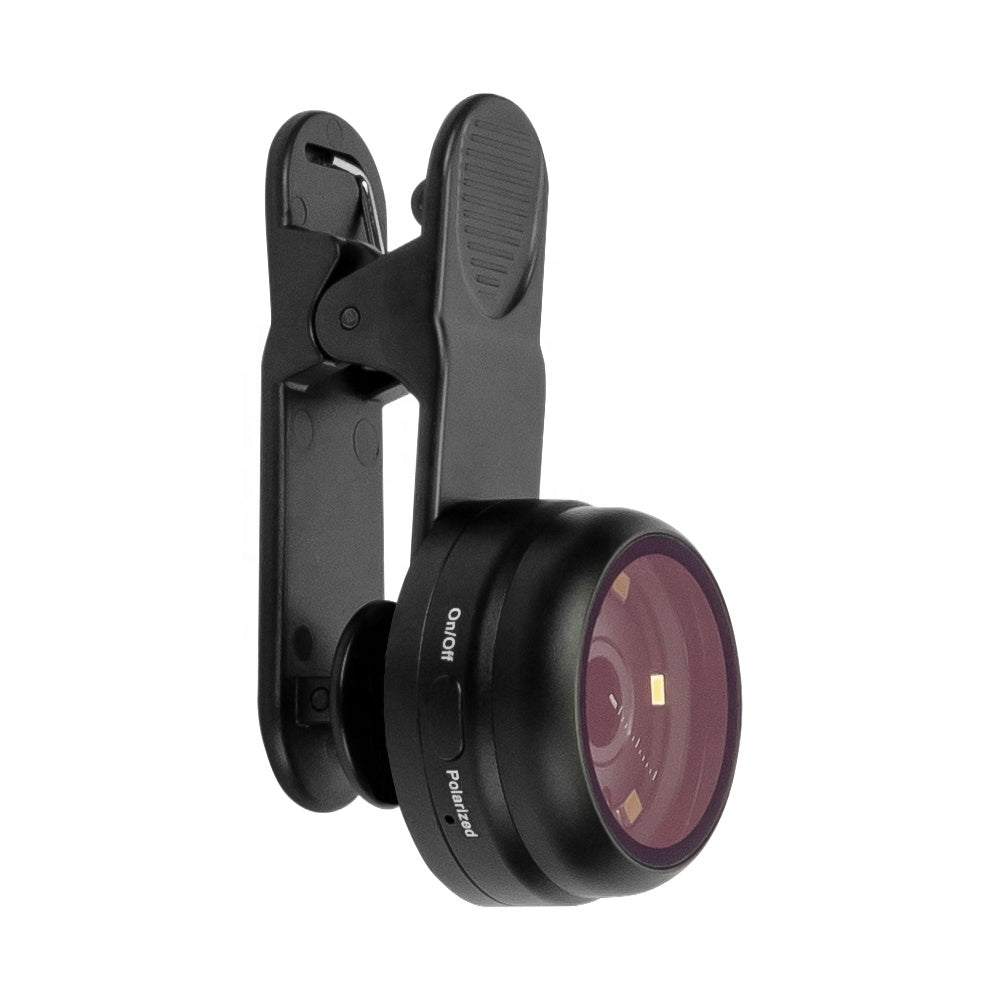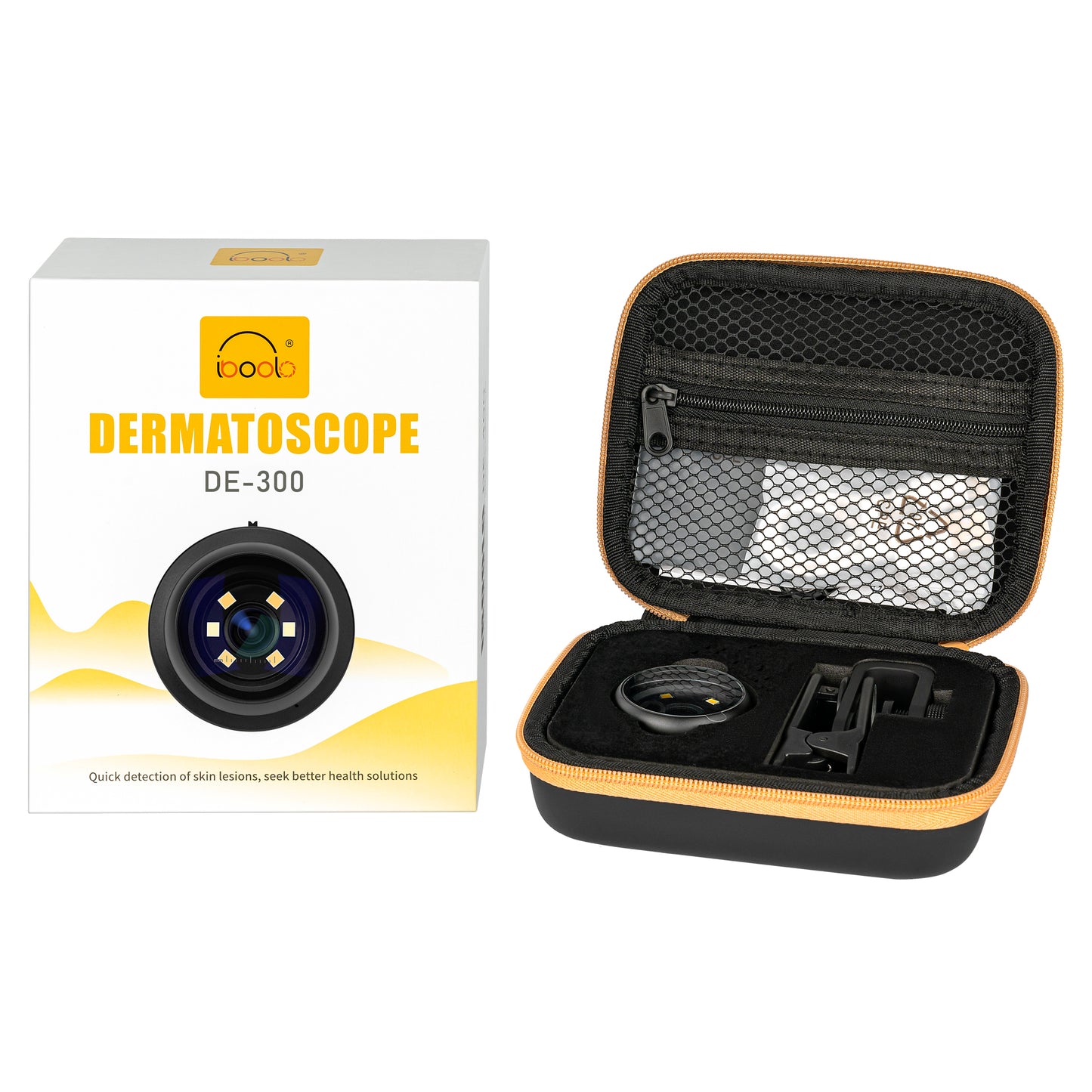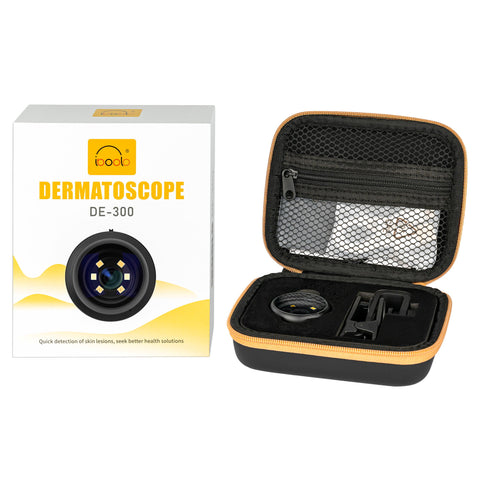SKU:
IBOOLO
IBOOLO DE-300 Economic Dermatoscope Skin Analyzer Machine for Primary Care
IBOOLO DE-300 Economic Dermatoscope Skin Analyzer Machine for Primary Care
Used by Dermatologist in 30+countries
FDA-Cleared CE Certified
Tilgængelighed for afhentning kunne ikke indlæses
Advantages of DE-300
The IBOOLO DE-300 dermoscope is ideal for home use and hospital use. Combined with a smartphone, you can get amazing, high-quality images. It contains a universal phone adapter meaning convenient to connect with any smartphone or tablet to capture images.
• Polarized and non-polarized lighting
• Real 6x Magnification
 Technical Specifications
Technical Specifications![]()
| Name | Dermatoscope/Dermoscopy |
|
Item |
DE-300 |
| Material | Optical and Aluminum |
| Magnification | 6 times |
| LEDS | 6 LEDS |
| Light | Polarization and non polarization |
| Warranty | 2 Years |
| Certificate | CE FDA |
| Standard | ISO13485 ISO14001 |
| Brightness | 1 |
| Battery | 200mAh |
DE-300 Dermatoscope Features
This top-tier dermatoscope combines exceptional performance with affordability, making it an ideal choice for primary dermatology care. It features both polarized and non-polarized light modes, enabling comprehensive skin examinations by minimizing surface reflections and revealing deeper skin structures. Its user-friendly design and reliable functionality ensure accurate diagnostics, catering to a wide range of dermatological needs.


Lighting System
The DE-300 dermatoscope can be switched to both polarized and non polarized light model, available in different lesion diagnose situation.
The non polarized light is mainly used to observe superficial skin lesions with the help of visible light;
The polarized light can help to eliminate surface reflection and allow visualization of vascular structures. The instrument allows for visualization for deeper skin structures, such as blood vessels, collagen, and pigment in the dermis.

Compatibility

Iboolo DE300 Dermatoscope: Your Advanced Skin Analysis Camera
In the evolving landscape of dermatology and aesthetic medicine, precision and digital integration are paramount. The iboolo DE300 Dermatoscope emerges as a leading-edge solution, redefining how skin conditions are diagnosed and managed. This advanced dermascope camera combines superior imaging technology with seamless connectivity, making it an indispensable tool for modern medical practices.
Discover the iboolo DE300: Your Essential Dermatoscopic Camera
The DE300 is not just a digital dermatoscope; it's a comprehensive diagnostic system engineered for clarity, efficiency, and versatility. Designed to magnify and capture detailed images of skin surfaces and subsurface structures, it significantly enhances the identification of moles, plaques, pigmentation, and potential tumors. Unlike traditional optical dermatoscopes, the iboolo DE300 utilizes a high-resolution dermatoscopic camera and advanced LED lighting to deliver real-time digital imaging, robust storage capabilities, and crucial remote diagnostic functions.
Core Differentiators of the DE300 Dermatoscope:
- Advanced Imaging Technology: While traditional dermatoscopes offer clear visuals, they often lack image recording or standardized analysis. The iboolo DE300 dermatoscope ensures consistent, high-quality images with integrated software for annotations, comparisons, and precise measurement. This feature is vital for accurate diagnosis and longitudinal patient tracking, setting a new standard for camera dermoscopy.
- Dual-Light Modes for Enhanced Visibility: Equipped with both polarized and non-polarized light options, the dermascope camera reveals deeper dermal structures and vascular patterns, which are critical for the early detection of malignancies and comprehensive lesion assessment.
- Seamless Connectivity and Telemedicine Ready: Supporting both USB and WiFi connections, the DE300 integrates effortlessly with computers, tablets, and mobile devices. This multi-platform compatibility facilitates streamlined telemedicine consultations and cross-platform data management, features often absent in conventional models and crucial for modern healthcare delivery.
How to Maximize Your Diagnostic Workflow with the DE300
Effective use of the DE300 dermatoscope involves a streamlined workflow, ensuring accurate image acquisition and efficient patient management. Here's a quick guide:
- Device Preparation: Ensure the lens is clean and the battery is charged or the device is connected.
- Connection: Link your iboolo DE300 dermatoscope to a compatible device via USB or WiFi, and confirm software recognition.
- Image Acquisition: Gently position the lens on the skin, select the appropriate light mode (polarized or non-polarized), and capture high-definition images using the auto-focus and shutter.
- Analysis & Archiving: Utilize the companion software for detailed image analysis, annotations, and secure storage with patient IDs for easy retrieval and comprehensive record-keeping.
DE300 vs. The Competition: Why iboolo Leads in Dermascope Cameras
When considering the best dermascope camera for your practice, the iboolo DE300 consistently outperforms competitors, including models like the Firefly DE550, Heine DELTA 30, and FotoFinder Handyscope. Its combination of high-resolution imaging, user-friendly design, and robust features makes it a standout choice for advanced camera dermoscopy.
Key Advantages of the iboolo DE300:
- 1080P High-Definition Dermascope Camera: Ensures unparalleled clarity for precise lesion detail.
- User-Friendly & Portable: Designed for intuitive operation with minimal training, making it ideal for clinics, wards, and mobile screenings.
- Cost-Effective Innovation: Offers premium features and performance at a competitive price point, suitable for small-to-medium clinics and educational settings.
- Robust Image Management: Seamlessly integrates with hospital databases and EMR systems for efficient data handling.
While the Firefly DE550 might offer a budget-friendly option, it often compromises on advanced features and light modes. The Heine DELTA 30 excels in optical precision but lacks the digital storage and remote capabilities critical for modern practices. The iboolo DE300 strikes the perfect balance, delivering comprehensive functionality without the prohibitive cost of high-end research models like FotoFinder Handyscope.
The Crucial Role of Digital Dermoscopy with the iboolo DE300 in Early Melanoma Detection
Early detection of melanoma is paramount for improving patient outcomes. The iboolo DE300 dermatoscope transforms screening protocols by offering:
- High-Resolution Imaging: Reveals subtle pigment networks and irregular borders often missed by the naked eye.
- Longitudinal Analysis: The software enables precise time-series comparisons to track lesion progression over time.
- AI-Assisted Diagnostics (Optional Software Integration): Future-proofed for automated scoring of asymmetry and color variation, flagging potential malignancies with greater accuracy.
These capabilities position the DE300 as an indispensable tool for proactive skin cancer surveillance, significantly boosting early detection rates compared to traditional methods.
Why Choose the iboolo DE300 Dermatoscope?
For clinicians seeking precision, efficiency, and digital integration, the iboolo DE300 dermatoscope is the ultimate choice. It redefines camera dermoscopy with its superior imaging, versatile light system, and robust connectivity. Outperforming many traditional and even some digital dermatoscopes in portability, data management, and diagnostic accuracy, the DE300 streamlines follow-ups, enhances patient education, and empowers medical professionals. Invest in the iboolo DE300 and elevate your dermatological practice with cutting-edge technology.
Package Include

- DE-300 Dermatoscope
- Universal Phone Adapter
- Clean Cloth
- USB-C Cable
- Carry Case
- English Version User Manaul
Share

















